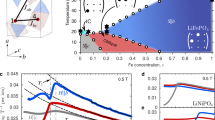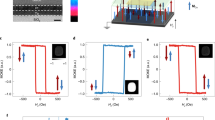Abstract
Controlling the magnetic anisotropy of ferromagnetic materials is key to the development of magnetic switching devices and spintronic applications. The intrinsic magnetic anisotropy of such materials is typically fixed along a particular direction—the magnetic easy axis. However, if the magnetic anisotropy could be continuously modulated, this could be used to create multifunctional devices. Here we report the gate-tunable modulation of magnetic anisotropy—from an initial out-of-plane to a canted orientation and then finally to an in-plane orientation—in the van der Waals ferromagnet Fe5GeTe2. We use angle-dependent anomalous Hall effect measurements and magneto-optical Kerr effect measurements, combined with quantitative Stoner–Wohlfarth analysis, to show that the magnetic easy axis continuously rotates via a spin-flop pathway and can be modulated in a large range from 2.11 to −0.38 MJ m–3. The tuning of anisotropy can also be achieved by modulating the temperature.
This is a preview of subscription content, access via your institution
Access options
Access Nature and 54 other Nature Portfolio journals
Get Nature+, our best-value online-access subscription
$29.99 / 30 days
cancel any time
Subscribe to this journal
Receive 12 digital issues and online access to articles
$119.00 per year
only $9.92 per issue
Buy this article
- Purchase on Springer Link
- Instant access to full article PDF
Prices may be subject to local taxes which are calculated during checkout




Similar content being viewed by others
Data availability
Source data are provided with this paper. Further data that support the other findings of this study are available from the corresponding authors upon reasonable request.
References
Gong, C. et al. Discovery of intrinsic ferromagnetism in two-dimensional van der Waals crystals. Nature 546, 265–269 (2017).
Huang, B. et al. Layer-dependent ferromagnetism in a van der Waals crystal down to the monolayer limit. Nature 546, 270–273 (2017).
Otte, A. F. et al. The role of magnetic anisotropy in the Kondo effect. Nat. Phys. 4, 847–850 (2008).
Ikeda, S. et al. A perpendicular-anisotropy CoFeB–MgO magnetic tunnel junction. Nat. Mater. 9, 721–724 (2010).
Chiba, D. et al. Magnetization vector manipulation by electric fields. Nature 455, 515–518 (2008).
Manchon, A., Koo, H. C., Nitta, J., Frolov, S. M. & Duine, R. A. New perspectives for Rashba spin–orbit coupling. Nat. Mater. 14, 871–882 (2015).
Fukami, S., Anekawa, T., Zhang, C. & Ohno, H. A spin–orbit torque switching scheme with collinear magnetic easy axis and current configuration. Nat. Nanotechnol. 11, 621–625 (2016).
Gambardella, P. et al. Giant magnetic anisotropy of single cobalt atoms and nanoparticles. Science 300, 1130–1133 (2003).
Maruyama, T. et al. Large voltage-induced magnetic anisotropy change in a few atomic layers of iron. Nat. Nanotechnol. 4, 158–161 (2009).
Nakamura, K. et al. Giant modification of the magnetocrystalline anisotropy in transition-metal monolayers by an external electric field. Phys. Rev. Lett. 102, 187201 (2009).
Verzhbitskiy, I. A. et al. Controlling the magnetic anisotropy in Cr2Ge2Te6 by electrostatic gating. Nat. Electron. 3, 460–465 (2020).
Kan, D. et al. Tuning magnetic anisotropy by interfacially engineering the oxygen coordination environment in a transition metal oxide. Nat. Mater. 15, 432–437 (2016).
Sears, J. A. et al. Ferromagnetic Kitaev interaction and the origin of large magnetic anisotropy in α-RuCl3. Nat. Phys. 16, 837–840 (2020).
Egger, R. & Schoeller, H. RKKY interaction and Kondo screening cloud for strongly correlated electrons. Phys. Rev. B 54, 16337–16340 (1996).
Andreani, L. C., Pavarini, E., Liviotti, E., Santini, P. & Amoretti, G. Competition between Kondo effect and magnetic interaction in Kondo systems. Phys. B Condens. Matter 230, 523–528 (1997).
Yamamoto, S. J. & Si, Q. Metallic ferromagnetism in the Kondo lattice. Proc. Natl Acad. Sci. USA 107, 15704–15707 (2010).
Misiorny, M., Hell, M. & Wegewijs, M. R. Spintronic magnetic anisotropy. Nat. Phys. 9, 801–805 (2013).
Wang, M. X., Zhang, Y., Zhao, X. X. & Zhao, W. S. Tunnel junction with perpendicular magnetic anisotropy: status and challenges. Micromachines 6, 1023–1045 (2015).
May, A. F. et al. Ferromagnetism near room temperature in the cleavable van der Waals crystal Fe5GeTe2. ACS Nano 13, 4436–4442 (2019).
Zhang, H. et al. Itinerant ferromagnetism in van der Waals Fe5–xGeTe2 crystals above room temperature. Phys. Rev. B 102, 064417 (2020).
Kittel, C. Physical theory of ferromagnetic domains. Rev. Mod. Phys. 21, 541–583 (1949).
Zhang, Y. et al. Emergence of Kondo lattice behavior in a van der Waals itinerant ferromagnet, Fe3GeTe2. Sci. Adv. 4, eaao6791 (2018).
Zhao, M. et al. Kondo holes in the two-dimensional itinerant Ising ferromagnet Fe3GeTe2. Nano Lett. 21, 6117–6123 (2021).
Ly, T. T. et al. Direct observation of Fe-Ge ordering in Fe5–xGeTe2 crystals and resultant helimagnetism. Adv. Funct. Mater. 31, 2009758 (2021).
Wu, X. et al. Direct observation of competition between charge order and itinerant ferromagnetism in the van der Waals crystal Fe5–xGeTe2. Phys. Rev. B 104, 165101 (2021).
Meng, L. et al. Anomalous thickness dependence of Curie temperature in air-stable two-dimensional ferromagnetic 1T-CrTe2 grown by chemical vapour deposition. Nat. Commun. 12, 809 (2021).
Yu, Y. et al. Gate-tunable phase transitions in thin flakes of 1T-TaS2. Nat. Nanotechnol. 10, 270–276 (2015).
Deng, Y. et al. Gate-tunable room-temperature ferromagnetism in two-dimensional Fe3GeTe2. Nature 563, 94–99 (2018).
May, A. F., Bridges, C. A. & McGuire, M. A. Physical properties and thermal stability of Fe5–xGeTe2 single crystals. Phys. Rev. Mater. 3, 104401 (2019).
Nagaosa, N., Sinova, J., Onoda, S., MacDonald, A. H. & Ong, N. P. Anomalous Hall effect. Rev. Mod. Phys. 82, 1539–1592 (2010).
Onoda, S., Sugimoto, N. & Nagaosa, N. Quantum transport theory of anomalous electric, thermoelectric, and thermal Hall effects in ferromagnets. Phys. Rev. B 77, 165103 (2008).
Tian, Y., Ye, L. & Jin, X. Proper scaling of the anomalous Hall effect. Phys. Rev. Lett. 103, 087206 (2009).
Kim, D., Lee, C., Jang, B. G., Kim, K. & Shim, J. H. Drastic change of magnetic anisotropy in Fe3GeTe2 and Fe4GeTe2 monolayers under electric field studied by density functional theory. Sci. Rep. 11, 17567 (2021).
Wang, Y. P., Chen, X. Y. & Long, M. Q. Modifications of magnetic anisotropy of Fe3GeTe2 by the electric field effect. Appl. Phys. Lett. 116, 092404 (2020).
Wang, Z. et al. Electric-field control of magnetism in a few-layered van der Waals ferromagnetic semiconductor. Nat. Nanotechnol. 13, 554–559 (2018).
Seo, J. et al. Nearly room temperature ferromagnetism in a magnetic metal-rich van der Waals metal. Sci. Adv. 6, eaay8912 (2020).
Park, S. Y. et al. Controlling the magnetic anisotropy of the van der Waals ferromagnet Fe3GeTe2 through hole doping. Nano Lett. 20, 95–100 (2020).
León-Brito, N., Bauer, E. D., Ronning, F., Thompson, J. D. & Movshovich, R. Magnetic microstructure and magnetic properties of uniaxial itinerant ferromagnet Fe3GeTe2. J. Appl. Phys. 120, 083903 (2016).
Xu, Y. et al. Coexisting ferromagnetic–antiferromagnetic state in twisted bilayer CrI3. Nat. Nanotechnol. 17, 143–147 (2022).
Ohno, H. A window on the future of spintronics. Nat. Mater. 9, 952–954 (2010).
Liu, L. et al. Symmetry-dependent field-free switching of perpendicular magnetization. Nat. Nanotechnol. 16, 277–282 (2021).
Mishra, R. et al. Electric-field control of spin accumulation direction for spin-orbit torques. Nat. Commun. 10, 248 (2019).
Soldatov, I. V. & Schafer, R. Selective sensitivity in Kerr microscopy. Rev. Sci. Instrum. 88, 073701 (2017).
Soldatov, I. V. & Schafer, R. Advances in quantitative Kerr microscopy. Phys. Rev. B 95, 014426 (2017).
Tan, C. et al. Hard magnetic properties in nanoflake van der Waals Fe3GeTe2. Nat. Commun. 9, 1554 (2018).
Acknowledgements
This work was supported by the A3 Foresight Program—Emerging Materials Innovation. We acknowledge the National Natural Science Foundation of China (grant nos. 51861145201 (H.T.Y.), 52072168 (H.T.Y.), 21733001 (H.T.Y.), 91750101 (H.T.Y.), 51732010 (Z. Liu), 52090020 (Y.T.), 52288102 (Y.T.) and 12204232 (F.Q.)), the Joint Funds of the National Natural Science Foundations of China (grant no. U21A2086 (Z. Liu)), the National Key R&D Program of China (grant nos. 2018YFA0306200 (H.T.Y.) and 2021YFA1202901 (J.H.)), the Natural Science Foundation of Jiangsu Province (grant no. BK20220758 (F.Q.)) and KAKENHI grant JP19H05602 (Y.I.) from the Japan Society for the Promotion of Science (JSPS) and JST PRESTO (grant no. JPMJPR19L1 (T.I.)).
Author information
Authors and Affiliations
Contributions
H.T.Y., Y.I. and L. Wang conceived this project. K.Z., L. Wang, Z. Liu and Y.T. grew the Fe5GeTe2 crystals. A.N. and Y.T. performed structural characterization using scanning transmission electron microscopy. M.T., C.Z., L.Z. and C.Q. fabricated the devices. M.T., J.H., P.C. and Z. Li performed the electrical measurements. X.B. performed thickness characterization using atomic force microscopy. M.T., F.M. and L. Wu performed the polar MOKE measurements. M.T., F.Q., T.I., P.T., H.Z., X.W. and Y.I. analysed the transport data. M.T., F.Q. and H.T.Y. wrote the manuscript with input from all the authors.
Corresponding authors
Ethics declarations
Competing interests
The authors declare no competing interests.
Peer review
Peer review information
Nature Electronics thanks the anonymous reviewers for their contribution to the peer review of this work.
Additional information
Publisher’s note Springer Nature remains neutral with regard to jurisdictional claims in published maps and institutional affiliations.
Supplementary information
Supplementary Information
Supplementary Figs. 1–25, Tables 1–4 and Notes 1–17.
Source data
Source Data Fig. 1
Statistical source data.
Source Data Fig. 2
Statistical source data.
Source Data Fig. 3
Statistical source data.
Source Data Fig. 4
Statistical source data.
Rights and permissions
Springer Nature or its licensor (e.g. a society or other partner) holds exclusive rights to this article under a publishing agreement with the author(s) or other rightsholder(s); author self-archiving of the accepted manuscript version of this article is solely governed by the terms of such publishing agreement and applicable law.
About this article
Cite this article
Tang, M., Huang, J., Qin, F. et al. Continuous manipulation of magnetic anisotropy in a van der Waals ferromagnet via electrical gating. Nat Electron 6, 28–36 (2023). https://doi.org/10.1038/s41928-022-00882-z
Received:
Accepted:
Published:
Issue Date:
DOI: https://doi.org/10.1038/s41928-022-00882-z



